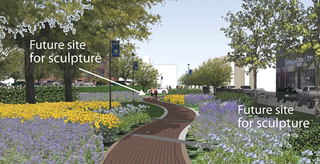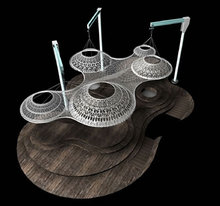 Maybe the National Endowment for the Arts is getting better: A new round of grants looks somewhat promising to me.
Maybe the National Endowment for the Arts is getting better: A new round of grants looks somewhat promising to me.
Except for my last post, which praised NEA chief Rocco Landesman’s attempts to get more money for the arts via HUD and DOT programs, I’ve been fairly critical about the NEA in the Obama Administration. But the grants announced by Landesman this morning through the NEA Mayors’ Institute on City Design 25th Anniversary Initiative (MICD 25) — a new program billed here as “Neighborhood transformation through the arts is the goal of 21 selected projects” — may make a difference.
I’m still not completely on-board with the MICD 25 program: I think it places too much of a burden on arts to create economic activity, and verges too much toward what commercial developers could/should so. Equally troubling, some grants go to the continuation of existing projects — which means that the cities probably would have found other funding for them without the NEA.
For example, the Horace Bushnell Memorial Corporation in Hartford won $250,00 to “support phase two of the iQuilt project, which will focus primarily on design. Expected activities include landscape design of the GreenWalk intended to connect Bushnell Park and the revitalized Connecticut River waterfront and urban design and enhancement of the existing pedestrian network…”
 Still, some winning projects look good.
Still, some winning projects look good.
And, in contrast to so many NEA grants, these are larger — a few are $25,000, but others go up to $250,000. I like that: in general, I favor larger grants that make a difference rather than tiny amounts that supposedly provide a stamp of approval.
Let’s back up and state the program goal:
Each of the MICD25 projects takes a problem such as isolated neighborhoods or a neglected waterfront and uses the arts to solve that problem. The aesthetic and communal qualities of art make them excellent construction materials for transforming physical spaces. Although the arts are at the center of each of the projects, the grantees are extending beyond the arts world to collaborate with local entities such as chambers of commerce, downtown redevelopment councils, departments of transportation, urban planning offices, and park and recreation offices.
So who won? Some cities, like Milwaukee, basically got necessary but ho-hum planning grants. But here are a few I like:
-
Rochester, NY: $250,000: “…to enhance the [ARTWalk] trail (pictured, top), commissioning additional public art pieces…including creating Centennial Sculpture Park, a two-acre park at the University of Rochester Memorial Art Gallery…[and] Poet’s Walk, which will identify historically significant poets with local ties, and Story Walk, a sidewalk that will wind through Centennial Sculpture Park and involve multimedia interaction, such as embedded audio performances.”
-
Indianapolis Museum of Art: $250,000 to “…work with artist Mary Miss and other partners…to create FLOW (Can You See the River?), [a] series of collaborative public art installations — or “Stopping Points” — along a stretch of the White River and Central Canal…intended to reveal significant aspects of the river system, thereby enhancing the community’s awareness of the White River, river-related issues, and efforts around maintaining the health of the city’s water supply.”
-
Paterson, N.J. (Development Corp.): $100,000 “for its Great Falls Arts and Creative Revitalization Initiative, which will engage the city’s artistic community in a collaborative process to create artistic events, works of art, and programs to both inaugurate the new national park and establish a permanent presence for the arts in ongoing revitalization efforts.”
-
Arts Council for Long Beach: $25,000 to “commission the design of a portable, flexible festival stage/set/performance space
[concept rendering, above right][see comment below] that will be used by arts presenting organizations throughout the city for special events and community festivals.” -
Shreveport Regional Arts Council: $200,000 to “develop Shreveport Commons over a seven-block area along Common Street that will house visual and performance venues side by side with existing community service institutions, religious institutions, and new businesses.”
The entire list is here.
If I recall correctly, the NEA has $5 million to spend on this program this year: See comment below.
Landesman has spent $3 million on 21 projects. Too early to say it’s a good start — but it’s not a bad one if arts infrastructure is the goal.
